Property "Joined with" (as page type) with input value "Anastasia Romanovna Zakharina-Yuryeva (c1530-1560) + Maria Temryukovna Cherkasskaya (c1545-1569) + Marfa Vasilyevna Sobakina (1552-1571) + Anna Aleskeyevna Koltovskaya (c1555-1626) + Maria Dolgorukaya (c1560-1573) + Anna Ivanovna Vasilchikova (c1557-c1576) + Vasilisa Ignatyevna Melentyeva (c1550-1579) + Maria Fyodorovna Nagaya (c1565-1608)" contains invalid characters or is incomplete and therefore can cause unexpected results during a query or annotation process.
| Wikipedia | |||||
| |||||
Ivan IV Vasilyevich the Terrible Rurik of Russia, Grand Prince of Moscow, Tsar of Russia, was born 25 August 1530 in Kolomenskoye, Russia to Vasili III Ivanovich of Russia (1479-1533) and Elena Vasilievna Glinskaya (1506-1538) and died 28 March 1584 Moscow, Russia of unspecified causes. He married Anastasia Romanovna Zakharina-Yuryeva (c1530-1560) 1547 JL . He married Maria Temryukovna Cherkasskaya (c1545-1569) 1561 JL . He married Marfa Vasilyevna Sobakina (1552-1571) 1571 JL . He married Anna Aleskeyevna Koltovskaya (c1555-1626) 1572 JL . He married Vasilisa Ignatyevna Melentyeva (c1550-1579) 1577 JL . He married Maria Fyodorovna Nagaya (c1565-1608) 1581 JL .
Ivan IV Vasilyevich (Russian: Ива́н Четвёртый Васи́льевич, Ivan Chetvyorty Vasilyevich; 25 August 1530 – 28 March [O.S. 18 March] 1584),[1] known in English as Ivan the Terrible (Russian: Ива́н Гро́зный (help·info), Ivan Grozny; lit. Fearsome), was Grand Prince of Moscow from 1533 until his death. His long reign saw the conquest of the Khanates of Kazan, Astrakhan, and Siberia, transforming Russia into a multiethnic and multiconfessional state spanning almost one billion acres, approximately 4,046,856 km2 (1,562,500 sq mi).[2] Ivan managed countless changes in the progression from a medieval state to an empire and emerging regional power, and became the first ruler to be crowned as Tsar of all Russia.
Historic sources present disparate accounts of Ivan's complex personality: he was described as intelligent and devout, yet given to rages and prone to episodic outbreaks of mental illness. On one such outburst Tsar beat and unpremeditatedly killed his groomed and chosen heir Ivan Ivanovich. This led Tsardom to be passed to Tsar's younger son: the weak and intellectually disabled[3] Feodor I of Russia. Ivan's legacy is complex: he was an able diplomat, a patron of arts and trade, founder of the Russia's first Print Yard, but he is also remembered for his paranoiac suspiciousness and cruel persecution of nobility.
Sobriquet
The English word terrible is usually used to translate the Russian word grozny in Ivan's nickname, but the modern English usage of terrible, with a pejorative connotation of bad or evil, does not precisely represent the intended meaning. The meaning of grozny is closer to the original usage of terrible—inspiring fear or terror, dangerous (as in Old English in one's danger), formidable or threatening. Other translations were suggested, such as Ivan the Fearsome or Ivan the Formidable.[4][5][6]
Early life
Ivan was the son of Vasili III and his second wife, Elena Glinskaya. When Ivan was three years old, his father died from a boil and inflammation on his leg which developed into blood poisoning. Ivan was proclaimed the Grand Prince of Moscow at his father's request. At first, his mother Elena Glinskaya acted as regent, but she died of what many believe to be assassination by poison[7][8] when Ivan was only eight years old. According to his own letters, Ivan, along with his younger brother Yuri, often felt neglected and offended by the mighty boyars from the Shuisky and Belsky families.
Ivan was crowned with Monomakh's Cap at the Cathedral of the Dormition at age 16 on 16 January 1547. He was the first person to be crowned as "Tsar of All the Russias", hence, claiming the ancestry of Kievan Rus. Prior to that, rulers of Muscovy were crowned as Grand Princes, although Ivan III the Great, his grandfather, styled himself "tsar" in his correspondence.
By being crowned Tsar, Ivan was sending a message to the world and to Russia: he was now the one and only supreme ruler of the country, and his will was not to be questioned. "The new title symbolized an assumption of powers equivalent and parallel to those held by former Byzantine caesar and the Tatar khan, both known in Russian sources as Tsar. The political effect was to elevate Ivan's position."[9] The new title not only secured the throne, but it also granted Ivan a new dimension of power, one intimately tied to religion. He was now a "divine" leader appointed to enact God's will, "church texts described Old Testament kings as 'Tsars' and Christ as the Heavenly Tsar."[10] The newly appointed title was then passed on from generation to generation, "succeeding Muscovite rulers...benefited from the divine nature of the power of the Russian monarch...crystallized during Ivan's reign."[11]
Domestic policy
Despite calamities triggered by the Great Fire of 1547, the early part of Ivan's reign was one of peaceful reforms and modernization. Ivan revised the law code (known as the sudebnik), created a standing army (the streltsy),[12] established the Zemsky Sobor or assembly of the land, a public, consensus-building assembly, the council of the nobles (known as the Chosen Council), and confirmed the position of the Church with the Council of the Hundred Chapters, which unified the rituals and ecclesiastical regulations of the entire country. He introduced local self-government to rural regions, mainly in the northeast of Russia, populated by the state peasantry.
By Ivan's order in 1553 the Moscow Print Yard was established and the first printing press was introduced to Russia. The 1550s and 1560s saw the printing of several religious books in Russian. The new technology provoked discontent with traditional scribes, which led to the Print Yard being burned in an arson attack and the first Russian printers Ivan Fedorov and Pyotr Mstislavets being forced to flee from Moscow to the Grand Duchy of Lithuania. Nevertheless, printing of books resumed from 1568 onwards, with Timofey Nevezha and his son Andronik now heading the Print Yard.
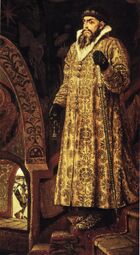
Portrait of Ivan IV by Viktor Vasnetsov, 1897 (Tretyakov Gallery, Moscow)
Ivan had St. Basil's Cathedral constructed in Moscow to commemorate the seizure of Kazan. Legend has it that he was so impressed with the structure that he had the architect, Postnik Yakovlev, blinded so that he could never design anything as beautiful again. In reality, Postnik Yakovlev went on to design more churches for Ivan and Kazan's Kremlin walls in the early 1560s, as well as the chapel over St. Basil's grave that was added to St. Basil's Cathedral in 1588, several years after Ivan's death. Although more than one architect was associated with this name and constructions, it is believed that the principal architect is one and the same person.[13][14][15]
Other events of this period include the introduction of the first laws restricting the mobility of the peasants, which would eventually lead to serfdom.
The 1560s brought hardships to Russia that led to dramatic change of Ivan's policies. Russia was devastated by a combination of drought and famine, Polish-Lithuanian raids, Tatar invasions and the sea-trading blockade carried out by the Swedes, Poles and the Hanseatic League. His first wife, Anastasia Romanovna, died in 1560, and her death was suspected to be a poisoning. This personal tragedy deeply hurt Ivan and is thought to have affected his personality, if not his mental health. At the same time, one of Ivan's advisors, Prince Andrei Kurbsky, defected to the Lithuanians, took command of the Lithuanian troops and devastated the Russian region of Velikiye Luki. The series of treasons made Ivan paranoically suspicious of nobility.
Oprichnina
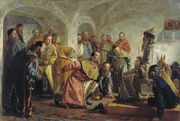
The Oprichniki by Nikolai Nevrev. The painting shows the last minutes of boyarin Feodorov, arrested for treason. To mock his alleged ambitions on the Tsar's title, the nobleman was given Tsar's regals before execution.
On December 3, 1564, Ivan IV departed Moscow for Aleksandrova Sloboda. From there he sent two letters in which he announced his abdication because of the alleged embezzlement and treason of the aristocracy and clergy. The boyar court was unable to rule in the absence of Ivan and feared the wrath of the Muscovite citizenry. A boyar envoy departed for Aleksandrova Sloboda to beg Ivan to return to the throne.[16] Ivan IV agreed to return on condition of being granted absolute power. He demanded that he should be able to execute and confiscate the estates of traitors without interference from the boyar council or church. Upon this, Ivan decreed the creation of the oprichnina.[17]
The oprichnina consisted of a separate territory within the borders of Russia, mostly in the territory of the former Novgorod Republic in the north. Ivan held exclusive power over the oprichnina territory. The Boyar Council ruled the zemshchina ('land'), the second division of the state. Ivan also recruited a personal guard known as the oprichniki. Originally it was a thousand strong.[18] The oprichniki were headed by Malyuta Skuratov. The oprichniki enjoyed social and economic privileges under the oprichnina. They owed their allegiance and status to Ivan, not to heredity or local bonds.[19]
The first wave of persecutions targeted primarily the princely clans of Russia, notably the influential families of Suzdal’. Ivan executed, exiled, or forcibly tonsured prominent members of the boyar clans on questionable accusations of conspiracy. Among those executed were the Metropolitan Philip and the prominent warlord Alexander Gorbaty-Shuisky. In 1566 Ivan extended the oprichnina to eight central districts. Of the 12,000 nobles there, 570 became oprichniks, the rest were expelled.[20]
Under the new political system, the Oprichniki were given large estates, but unlike the previous landlords, could not be held accountable for their actions. These men, "took virtually all the peasants possessed, forcing them to pay 'in one year as much as [they] used to pay in ten.'"[21] This degree of oppression resulted in increasing cases of peasants fleeing which in turn led to a drop in the overall production. The price of grain increased by a factor of ten.
Conditions were worsened by the 1570 epidemics of plague that killed 10,000 people in Novgorod. The plague killed 600–1000 in Moscow daily.[22]
Sack of Novgorod
During the grim conditions of the epidemics, famine and ongoing Livonian war, Ivan grew suspicious that noblemen of the wealthy city of Novgorod were planning to defect, placing the city itself into the control of the Grand Duchy of Lithuania. In 1570 Ivan ordered the Oprichniki to raid the city. The Oprichniki burned and pillaged Novgorod and the surrounding villages, and the city was never to regain its former prominence.[23]
Casualty figures vary greatly in different sources. The First Pskov Chronicle estimates the number of victims at 60,000.[23][24][25][25] Yet the official death toll named 1,500 of Novgorod's big people (nobility) and mentioned only about the same number of smaller people. Many modern researchers estimate the number of victims to range from 2000–3000 (after the famine and epidemics of 1560s the population of Novgorod most likely did not exceed 10,000–20,000).[26] Many survivors were deported elsewhere.
Oprichnina did not live long after the sack of Novgorod. During the 1571-1572 Russo-Crimean war, oprichniks failed to prove themselves worthy against a regular army. In 1572, Ivan abolished the Oprichnina and disbanded his oprichniks.
Foreign policy
Diplomacy and trade
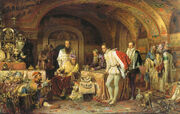
Ivan the Terrible Showing His Treasures to Jerome Horsey by Alexander Litovchenko (1875)
In 1547 Hans Schlitte, the agent of Ivan, recruited craftsmen in Germany for work in Russia. However all these craftsmen were arrested in Lübeck at the request of Poland and Livonia. The German merchant companies ignored the new port built by Ivan on the river Narva in 1550 and continued to deliver goods in the Baltic ports owned by Livonia. Russia remained isolated from sea trade.
Ivan established very close ties with England. Russo-English relations can be traced to 1553, when Richard Chancellor sailed to the White Sea and continued overland to Moscow. Upon his return to England in 1555, the Muscovy Company was formed by himself, Sebastian Cabot, Sir Hugh Willoughby, and several London merchants. Ivan opened up the White Sea and the port of Arkhangelsk to the Company and granted the Company privilege of trading throughout his reign without paying the standard customs fees.[27] Muscovy Company retained the monopoly in Russo-English trade until 1698.
With the use of English merchants, Ivan engaged in a long correspondence with Queen Elizabeth. While the queen focused on commerce, Ivan was more interested in a military alliance. During his troubled relations with the boyars, the tsar even asked her for a guarantee to be granted asylum in England should his rule be jeopardised.
Ivan IV corresponded with Orthodox leaders overseas as well. In response to a letter of Patriarch Joachim of Alexandria asking the Tsar for financial assistance for the Monastery of St. Catherine in Sinai, which had suffered from the Turks, Ivan IV sent in 1558 a delegation to Egypt led by archdeacon Gennady, who, however, died in Constantinople before he could reach Egypt. From then on the embassy was headed by Smolensk merchant Vasily Poznyakov. Poznyakov's delegation visited Alexandria, Cairo and Sinai, brought the patriarch a fur coat and an icon sent by the Tsar and left an interesting account of its 2.5 years of travels.[28]
Conquest of Kazan and Astrakhan
While Ivan IV was a minor, armies of the Kazan Khanate repeatedly raided the northeast of Russia,[29] In the 1530s the Crimean khan formed an offensive alliance with Safa Giray of Kazan, his relative. When Safa Giray invaded Muscovy in December 1540, the Russians used Qasim Tatars to contain him. After his advance was stalled near Murom, Safa Giray was forced to withdraw to his own borders.
These reverses undermined Safa Giray's authority in Kazan. A pro-Russian party, represented by Shahgali, gained enough popular support to make several attempts to take over the Kazan throne. In 1545 Ivan IV mounted an expedition to the Volga River to show his support for pro-Russian factions.
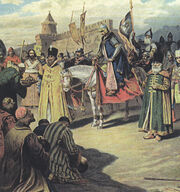
Ivan IV under the walls of Kazan by Pyotr Korovin
In 1551 the tsar sent his envoy to the Nogai Horde and they promised to maintain neutrality during the impending war. The Ar begs and Udmurts submitted to Russian authority as well. In 1551 the wooden fort of Sviyazhsk was transported down the Volga from Uglich all the way to Kazan. It was used as the Russian place d'armes during the decisive campaign of 1552.
On 16 June 1552 Ivan IV led a 150,000-strong Russian army towards Kazan. The last siege of the Tatar capital was commenced on 30 August. Under the supervision of Prince Alexander Gorbaty-Shuisky, the Russians used ram weapons, a battery-tower, mines, and 150 cannons. The Russians also had the advantage of efficient military engineers. The city's water supply was blocked and the walls were breached. Kazan finally fell on 2 October, its fortifications were razed, and much of the population massacred. About 60,000 - 100,000 Russian prisoners and slaves were released. The Tsar celebrated his victory over Kazan by building several churches with oriental features, most famously Saint Basil's Cathedral on Red Square in Moscow.
The fall of Kazan had as its primary effect the outright annexation of the Middle Volga. The Bashkirs accepted Ivan IV's authority two years later. In 1556 Ivan annexed the Astrakhan Khanate and destroyed the largest slave market on the river Volga. These conquests complicated the migration of the aggressive nomadic hordes from Asia to Europe through Volga. As a result of the Kazan campaigns, Muscovy was transformed into the multinational and multi-faith state of Russia.
Livonian war
In an attempt to gain access to Baltic sea and its major trade routes, Ivan launched an ultimately unsuccessful 24 years Livonian war of seaward expansion to the west and finding himself fighting the Swedes, Lithuanians, Poles and the Livonian Teutonic Knights.
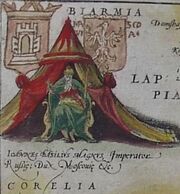
Ioannes Basilius Magnus Imperator Russiae, Dux Moscoviae by Abraham Ortelius (1574)
Having rejected peace proposals from his enemies, Ivan IV found himself in a difficult position by 1579. The displaced refugees fleeing the war compounded the effects of the simultaneous drought, and exacerbated war engendered epidemics, causing much loss of life.
Altogether the prolonged war had nearly destroyed the economy, Oprichnina had thoroughly disrupted the government, while The Grand Principality of Lithuania had united with The Kingdom of Poland and acquired an energetic leader, Stefan Batory, who was supported by Russia's southern enemy, the Ottoman Empire (1576). Ivan's realm was now being squeezed by two of the great powers of the day.
After negotiations with Ivan failed, Batory launched a series of offensives against Muscovy in the campaign seasons of 1579–1581, trying to cut The Kingdom of Livonia from Muscovite territories. During his first offensive in 1579, he retook Polotsk with 22,000 men. During the second, in 1580, he took Velikie Luki with a 29,000-strong force. Finally, he began the Siege of Pskov in 1581 with a 100,000-strong army. Narva in Estonia was reconquered by Sweden in 1581.
Unlike Sweden and Poland, Frederick II had trouble continuing the fight against Muscovy. He came to an agreement with John III in 1580, giving him the titles in Livonia. That war would last from 1577 to 1582. Muscovy recognized Polish-Lithuanian control of Ducatus Ultradunensis only in 1582. After Magnus von Lyffland died in 1583, Poland invaded his territories in The Duchy of Courland and Frederick II decided to sell his rights of inheritance. Except for the island of Saaremaa, Denmark was out of the Baltic by 1585.
Crimean raids
In late years of Ivan's reign southern borders of Muscovy were disturbed by Crimean Tatars. Khan Devlet I Giray of Crimea repeatedly raided the Moscow region. In 1571, the 40,000-strong Crimean and Turkish army launched a large-scale raid. Due to ongoing Livonian war, Moscow's garrison was as small as 6,000, and could not even delay the Tatar approach. Unresisted, Devlet devastated unprotected towns and villages around Moscow and set Moscow on fire. Historians estimate the number of casualties of the fire from 10,000 to as many 80,000 people.
To buy peace from Devlet Giray, Ivan was forced to relinquish his rights on Astrakhan in favor of Crimean Khanate (although this proposed transfer was only a diplomatic maneuver and was never actually complete). This defeat angered Ivan. Upon his orders, between 1571 and 1572 preparations were made. In addition to Zasechnaya cherta, innovative fortifications were set beyond the river Oka that defined the border.
Next year Devlet launched another raid on Moscow, now with 120,000-strong[30] horde, equipped with cannons and reinforced by Turkish janissaries. On 26 July 1572 the horde crossed the Oka River near Serpukhov, decimated the Russian vanguard of 200 noblemen and advanced towards Moscow.
Russian army, led by Prince Mikhail Vorotynsky, was twice smaller, estimated at between 60,000-70,000 men, yet it was an experienced streltsi army, equipped with modern firearms and gulyay-gorods. On 30 July the armies clashed near the Lopasnya River in what will be known as the Battle of Molodi, that continued for more than a week. The outcome was decisive Russian victory. The Crimean horde was defeated so thoroughly that both the Ottoman Sultan and the Crimean khan, his vassal, had to give up their ambitious plans of northward expansion into Russia.
Conquest of Siberia
During Ivan's reign, Russia started a large-scale exploration and colonization of Siberia. In 1555, shortly after the conquest of Kazan, Siberian khan Yadegar and Nogai khan Ismail pledged their allegiance to Ivan, in hope that he would help them against their opponents. However, Yadegar failed to gather the full sum of tribute he proposed to the tsar, so Ivan did nothing to save his inefficient vassal. in 1563 Yadegar was overthrown and killed by khan Kuchum, who denied any tribute to Moscow.
In 1558 Ivan gave the Stroganov merchant family patent for colonizing "the abundant region along the Kama River", and in 1574 lands over the Ural Mountains along the rivers Tura and Tobol. They also received permission to build forts along the Ob and Irtysh rivers. Around 1577, the Stroganovs hired the Cossack leader Yermak Timofeyevich to protect their lands from attacks of the Siberian Khan Kuchum.
In 1580 Yermak started his conquest of Siberia. With some 540 Cossacks he started to penetrate territories that were tributary to Kuchum. Yermak persuaded the various family-based tribes to change their loyalties and become tributaries of Russia. He also established distant forts in the newly conquered lands. The campaign was successful, and cossacks managed to defeat Siberian army in Battle of Chuvash Cape, but Yermak was still in need for reinforcements. He sent an envoy to Ivan the Terrible, who agreed to reinforce the cossacks with his streltsi. Yermak's conquest expanded Ivan's empire to the east and allowed him to style himself "Tsar of Siberia" in the tsar's very last years.
Personal Life
Children
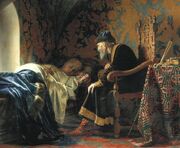
Tsar Ivan IV admires his sixth wife Vasilisa Melentyeva. 1875 painting by Grigory Semyonovich Sedov (1836–1886)
- By Anastasia Romanovna:
- Tsarevna Anna Ivanovna (10 August 1548 – 20 July 1550)
- Tsarevna Maria Ivanovna (17 March 1551 – young)
- Tsarevich Dmitri Ivanovich (October 1552 – 26 June 1553)
- Tsarevich Ivan Ivanovich (28 March 1554 – 19 November 1581)
- Tsarevna Eudoxia Ivanovna (26 February 1556 – June 1558)
- Tsar Feodor I of Russia (31 May 1557 – 6 January 1598)
- Tsarevich Vasili Ivanovich
- By Maria Nagaya:
- Tsarevich Dmitri Ivanovich
- By an uncertain mother:
- Xenia Shestova (possibly)
In 1581 Ivan beat his pregnant daughter-in-law for wearing immodest clothing, and this may have caused a miscarriage. His son, also named Ivan, upon learning of this, engaged in a heated argument with his father, resulting in Ivan striking his son in the head with his pointed staff, causing his son's death. This event is depicted in the famous painting by Ilya Repin, Ivan the Terrible and his son Ivan on Friday, 16 November 1581 better known as Ivan the Terrible killing his son.
Arts
Ivan was a poet, a composer of considerable talent, and supported the arts. His Orthodox liturgical hymn, "Stichiron No. 1 in Honor of St. Peter", and fragments of his letters were put into music by Soviet composer Rodion Shchedrin. The recording was released in 1988, marking the millennium of Christianity in Russia, and was the first Soviet-produced CD.[31][32][33]
Epistles
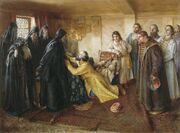
Ivan's repentance: he asks a father superior of the Pskovo-Pechorsky Monastery to let him take the tonsure at his monastery. Painting by Klavdiy Lebedev.
D.S. Mirsky called Ivan "a pamphleteer of genius". The epistles attributed to him are the masterpieces of old Russian (perhaps all Russian) political journalism. They may be too full of texts from the Scriptures and the Fathers, and their Church Slavonic is not always correct, but they are full of cruel irony, expressed in pointedly forcible terms.
The shameless bully and the great polemicist are seen together in a flash when he taunts the runaway prince Kurbsky with the question: "If you are so sure of your righteousness, why did you run away and not prefer martyrdom at my hands?" Such strokes were well calculated to drive his correspondent into a rage. "The part of the cruel tyrant elaborately upbraiding an escaped victim while he continues torturing those in his reach may be detestable, but Ivan plays it with truly Shakespearian breadth of imagination".[34] These letters are often the only existing source on Ivan's personality and provide crucial information on his reign, but Harvard professor Edward Keenan has argued that these letters are 17th century forgeries. This contention, however, has not been widely accepted, and other scholars, such as John Fennell and Ruslan Skrynnikov continued to argue for their authenticity. Recent archival discoveries of 16th century copies of the letters strengthen the argument for their authenticity.[35][36]
Besides his letters to Kurbsky he wrote other satirical invectives to men in his power. The best is his letter to the abbot of the Kirillo-Belozersky Monastery, where he pours out all the poison of his grim irony on the unascetic life of the boyars, shorn monks, and those exiled by his order. His picture of their luxurious life in the citadel of ascetism is a masterpiece of trenchant sarcasm.
Death
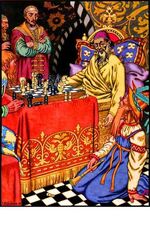
Death of Ivan the Terrible by Ivan Bilibin (1935)
Ivan died from a stroke while playing chess with Bogdan Belsky[37] on 28 March [O.S. 18 March] 1584.[37] Upon Ivan's death, the ravaged kingdom was left to his unfit and childless son Feodor. Feodor died childless in 1598, ushering in the Time of Troubles.
Legacy
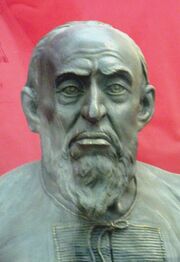
Forensic facial reconstruction of Ivan IV by Mikhail Gerasimov
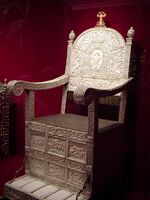
Ivan's throne (ivory, metal, wood)
In the centuries following Ivan's death, historians developed different theories to better understand his reign, but independent of the perspective through which one chooses to approach this, it cannot be denied that Ivan the Terrible changed Russian history and continues to live on in popular imagination. His political legacy completely altered the Russian governmental structure; his economic policies ultimately contributed to the end of the Rurik Dynasty, and his social legacy lives on in unexpected places.
Arguably Ivan's most important legacy can be found in the political changes he enacted in Russia. In the words of historian Alexander Yanov, "Ivan the Terrible and the origins of the modern Russian political structure [are]... indissolubly connected." [38]
A title alone may hold symbolic power, but Ivan's political revolution went further, in the process significantly altering Russia's political structure. The creation of the Oprichnina marked something completely new, a break from the past that served to diminish the power of the boyars and create a more centralized government. "...the revolution of Tsar Ivan was an attempt to transform an absolutist political structure into a despotism... the Oprichnina proved to be not only the starting point, but also the nucleus of autocracy which determined... the entire subsequent historical process in Russia."[39] Ivan created a way to bypass the Mestnichestvo system and elevate the men among the gentry to positions of power, thus suppressing the aristocracy that failed to support him.[40] Part of this revolution included altering the structure of local governments to include, "a combination of centrally appointed and locally elected officials. Despite later modifications, this form of local administration proved to be functional and durable." [11] Ivan successfully cemented autocracy and a centralized government in Russia, in the process also establishing "a centralized apparatus of political control in the form of his own guard."[41] The idea of a guard as a means of political control became so ingrained in Russian history that it can be traced to Peter the Great, Vladimir Lenin, who "... [provided] Russian autocracy with its Communist incarnation", and Joseph Stalin, who "[placed] the political police over the party." Yanov concludes that "Czar Ivan's monstrous invention [i.e. the guard] has thus dominated the entire course of Russian history."[42]
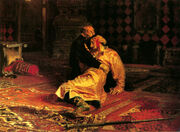
Ivan the Terrible And His Son Ivan, 16 November 1581 by Ilya Repin, 1885 (Tretyakov Gallery, Moscow)
By expanding into Poland (although a failed campaign), the Caspian and Siberia, Ivan established a sphere of influence that lasted until the 20th century. Ivan's conquests also ignited a conflict with Turkey that would lead to successive wars. "Russia's victories confined the Turkish conquests to the Balkans and the Black sea region, although Turkish expansionism continued to cast a shadow over the whole of Eastern Europe."[43]
The acquisition of new territory brought about another of Ivan's lasting legacies: a relationship with Europe, especially through trade. Although the contact between Russia and Europe remained small at this time, it would later grow, facilitating the permeation of European ideals across the border. Peter the Great would later push Russia to become a European power, and Catherine II would manipulate that power to make Russia a leader within the region.
Contrary to his political legacy, Ivan IV's economic legacy was disastrous and became one of the factors that led to the decline of the Rurik Dynasty and the Time of Troubles. Ivan inherited a government in debt, and in an effort to raise more revenue instituted a series of taxes. "It was the military campaigns themselves... that were responsible for the increasing government expenses."[44] To make matters worse, successive wars drained the country both of men and resources. "Muscovy from its core, where its centralized political structures depended upon a dying dynasty, to its frontiers, where its villages stood depopulated and its fields lay fallow, was on the brink of ruin."[45]
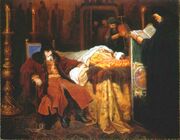
Ivan the Terrible meditating at the deathbed of his son. Ivan's murder of his son brought about the extinction of the Rurik Dynasty and the Time of Troubles. Painting by Vyacheslav Grigorievich Schwarz (1861).
Ivan's political revolution not only consolidated the position of Tsar, but also created a centralized government structure with ramifications extending to local government. "The assumption and active propaganda of the title of Czar, transgressions and sudden changes in policy during the Oprichnina contributed to the image of the Muscovite prince as a ruler accountable only to God."[11] Subsequent Russian rulers inherited a system put in place by Ivan.
Another interesting and unexpected aspect of Ivan's social legacy emerged within Communist Russia. In an effort to revive Russia nationalist pride, Ivan the Terrible's image became closely associated with Joseph Stalin.[46] Historians faced great difficulties when trying to gather information about Ivan IV in his early years because "Early Soviet historiography, especially in the 1920s, paid little attention to Ivan IV as a statesman." This, however, was not surprising because "Marxist intellectual tradition attached greater significance to socio-economic forces than to political history and the role of individuals." By the second half of the 1930s, the method used by Soviet historians changed. They placed a greater emphasis on the individual and history became more "comprehensible and accessible". The way was clear for an emphasis on 'great men', such as Ivan the Terrible and Peter the Great, who made a major contribution to the strengthening and expansion of the Russian state. From this time on, the Soviet Union's focus on great leaders would be greatly exaggerated, leading historians to gather more and more information on the great Ivan the Terrible.[47]
Today, there exists a controversial movement in Russia campaigning in favor of granting sainthood to Ivan IV.[48] The Russian Orthodox Church has stated its opposition to the idea.[49]
Cinema and literature
- The Soviet filmmaker Sergei Eisenstein made two films based on the life of the Great Tsar – Ivan the Terrible. The first film is about the early progressive years of Ivan as a young tsar, it was admired by Joseph Stalin. The second part tells us about the cruel period of Ivan's mature age. Stalin took this film rather coldly as it was too much like a mirror of the Soviet regime of that time. A third one was never completed.
- Tsar – a 2009 Russian drama film directed by Pavel Lungin.
- Ivan the Terrible in Russian folklore.
- In the movie Night at the Museum: Battle of the Smithsonian Ivan was played by Christopher Guest.
- In Deadliest Warrior season 3, he fights against Hernan Cortes and loses due to an inability to lead his troops stemming from his sickness and insanity.
- Russka (1991) the novel by Edward Rutherford
- In the popular Soviet era comedy film Ivan Vasilievich: Back to the Future featuring the serial character Engineer Shurik,[50] played by Aleksandr Demyanenko, Shurik inadvertently transports a character named Ivan Vasilevich Bunsha, played by acclaimed Russian actor Yury Yakovlev, to the time of Ivan the Terrible, also played by Yakovlev. Ivan the Terrible is simultaneously transported to the Soviet Union circa 1973, with Bunsha and Ivan the Terrible switching places and professions. The switch consequently results in a farcical tale with comedic hijinks arising, in large part, from the absurdity of placing the first recognized Tsar of All Russia into everyday 20th century Soviet life. The film is based on a play by Mikhail Bulgakov and was one of the most attended movies in the Soviet Union in 1973, with more than 60 million tickets sold.[51]
See also
- Tsars of Russia family tree
- Tsardom of Russia History of the Tsardom of Russia
References
Notes
- ^ 28 March: This Date in History. Webcitation.org. Retrieved 2011-12-07
- ^ Russia: Land of the Czars, History Channel
- ^ History International Channel coverage, 14:00–15:00 EDST on 10 June 2008
- ^ C. G. Jacobsen (1993). "Myths, Politics and the Not-so-New World Order". Journal of Peace Research 30 (3): 241–250. DOI:10.1177/0022343393030003001.
- ^ Roy Temple House, Ernst Erich Noth, University of Oklahoma. Books Abroad: An International Literary Quarterly. v. 15, 1941; p. 343. ISSN: 0006-7431.
- ^ Frank D. McConnell. Storytelling and Mythmaking: Images from Film and Literature. Oxford University Press, 1979. ISBN 0-19-502572-5; p. 78: "But Ivan IV, Ivan the Terrible, or as the Russian has it, Ivan groznyi, "Ivan the Magnificent" or "Ivan the Great" is precisely a man who has become a legend"
- ^ Martin, 331
- ^ Pushkareva, Women in Russian History, 65–67.
- ^ Martin, 377
- ^ Bogatyrev, 245
- ^ a b c Bogatyrev, 263.
- ^ Michael C. Paul, "The Military Revolution in Russia 1550–1682", The Journal of Military History 68 No. 1 (January 2004): 9–45, esp. pp. 20–22
- ^ Постник. Great Soviet Encyclopedia
- ^ Барма и Постник (Постник Яковлев) ecology-mef.narod.ru/
- ^ Постник Барма – строитель собора Василия Блаженного в Москве и Казанского кремля. russiancity.ru
- ^ Isabel De Madariaga, Ivan the Terrible: First Tsar of Russia (London: Yale University Press, 2005), 176-178; Andrei Pavlov and Maureen Perrie, Ivan the Terrible (London: Pearson Education Limited, 2003), 112-113
- ^ Isabel de Madariaga, Ivan the Terrible, pp. 179-80
- ^ Isabel De Madariaga, Ivan the Terrible: First Tsar of Russia (London: Yale University Press, 2005), 182-183; Andrei Pavlov and Maureen Perrie, Ivan the Terrible (London: Pearson Education Limited, 2003), 112-113
- ^ Andrei Pavlov and Maureen Perrie, Ivan the Terrible (London: Pearson Education Limited, 2003), 113
- ^ Isabel de Madariaga, Ivan the Terrible, p. 183; as the tonsure was the distinctive hairstyle of monastic orders, a forcibly "tonsured" boyar was effectively exiled from power by being made to enter a monastic life.
- ^ Martin, 410
- ^ R. Skrynnikov, "Ivan Grosny", Moscow, AST, 2001
- ^ a b Novgorod, Russia (Capital). 1911encyclopedia.org (2006-10-06). Retrieved 2011-12-07
- ^ Ivan the Terrible, Russia, (r.1533–84). Users.erols.com. Retrieved 2011-12-07
- ^ a b According to the Third Novgorod Chronicle, the massacre lasted for five weeks. Almost every day 500 or 600 people were killed or drowned.
- ^ Having investigated the report of Maljuta Skuratov and commemoration lists (sinodiki), R. Skrynnikov considers that the number of victims was 2,000–3,000. (Skrynnikov R. G., "Ivan Grosny", M., AST, 2001)
- ^ Martin, 407.
- ^ ХОЖДЕНИЕ НА ВОСТОК ГОСТЯ ВАСИЛИЯ ПОЗНЯКОВА С ТОВАРИЩИ (The travels to the Orient by the merchant Vasily Poznyakov and his companions) (Russian)
- ^ Russian chronicles record about 40 attacks of Kazan Khans on Russian territories (mainly the regions of Nizhniy Novgorod, Murom, Vyatka, Vladimir, Kostroma, and Galich) in the first half of the 16th century. In 1521 the combined forces of Khan Mehmed Giray and his Crimean allies attacked Russia, captured more than 150,000 slaves The Full Collection of the Russian Annals, vol.13, SPb, 1904
- ^ Новгородская вторая летопись. Год 7080(1572).ПСРЛ т. III, СПб, 1841
- ^ "Иван IV Грозный / Родион Константинович Щедрин – Стихиры (Первый отечественный компакт-диск)". http://www.intoclassics.net/news/2009-08-09-7942.
- ^ "Raritet-CD". http://www.raritet-cd.ru/.
- ^ Kuzin, Viktor. "Первый русский компакт-диск". http://www.rarity.ru/CONSALTING.htm.
- ^ D.S. Mirsky. A History of Russian Literature. Northwestern University Press, 1999. ISBN 0-8101-1679-0. p. 21
- ^ Edward L. Keenan, The Kurbskii-Groznyi Apocrypha: the 17th-Century Genesis of the "Correspondence" Attributed to Prince A. M. Kurbskii and Tsar Ivan IV (Cambridge, Massachusetts: Harvard University Press, 1971)
- ^ Martin, 328–329.
- ^ a b Waliszewski, Kazimierz; Mary Loyd (1904). Ivan the Terrible. Philadelphia: J.B. Lippincott. pp. 377–78. http://books.google.com/books?id=IEEEAAAAYAAJ&pg=PA377.
- ^ Yanov, 31
- ^ Yanov, 68.
- ^ Riasanovsky, Nicholas V., and Mark D. Steinberg. "Russia at the Time of Ivan IV, 1533–1598" in A History of Russia 8th ed. Vol. 1. New York: Oxford University Press, 2011, 151.
- ^ Yanov, 69.
- ^ Yanov, 70.
- ^ Shrynnikov, Ruslan G. "Conclusion" in Ivan the Terrible, translated by Hugh F. Graham. Moscow: Academic International, 1975, 199
- ^ Martin, 404.
- ^ Martin, 415.
- ^ Maureen, Perrie. The Cult of Ivan the Terrible in Stalin's Russia. New York: Palgrava, 2001.
- ^ Perrie, Maureen. The Image of Ivan the Terrible in Russian Folklore. Cambridge, UK: Pitt Building, 1987. Google Books. 2002. Web. 6 February 2011.
- ^ "Russians Laud Ivan the Not So Terrible; Loose Coalition Presses Orthodox Church to Canonize the Notorious Czar" Washington Post, 10 November 2003
- ^ "Church says nyet to St. Rasputin" UPI NewsTrack, 4 October 2004
- ^ Shurik, Character. IMDB.
- ^ Leaders of distribution (Russian)
Bibliography
- Bogatyrev, Sergei. "10. Ivan IV (1533–1584)". in The Cambridge History of Russia Vol. 1: From Early Rus' to 1689 Maureen Perrie (Ed.) Cambridge Histories Online (2006) doi:10.1017/CHOL9780521812276.011 ISBN 0-521-81227-5.
- Martin, Janet. "Ivan IV the Terrible" in Medieval Russia 980–1584 2nd ed. 1993. Reprint, New York: Cambridge University Press, 2007 ISBN 0-521-85916-6.
- Yanov, Alexander. The Origins of Autocracy. Los Angeles: University of California Press, 1981 ISBN 0-520-04282-4.
General references
- Bobrick, Benson. Ivan the Terrible. Edinburgh: Canongate Books, 1990 (hardcover, ISBN 0-86241-288-9). (Also published as Fearful Majesty)
- Hosking, Geoffrey. Russia and the Russians: A History. Cambridge: Harvard University Press, 2004 (paperback, ISBN 0-674-01114-7).
- Madariaga, Isabel de. Ivan the Terrible. First Tsar of Russia. New Haven; London: Yale University Press, 2005 (hardcover, ISBN 0-300-09757-3); 2006 (paperback, ISBN 0-300-11973-9).
- Payne, Robert; Romanoff, Nikita. Ivan the Terrible. Lanham, Maryland: Cooper Square Press, 2002 (paperback, ISBN 0-8154-1229-0).
- Troyat, Henri. Ivan the Terrible. New York: Buccaneer Books, 1988 (hardcover, ISBN 0-88029-207-5); London: Phoenix Press, 2001 (paperback, ISBN 1-84212-419-6).
- Ivan IV, World Book Inc, 2000. World Book Encyclopedia.
Further reading
- Cherniavsky, Michael. "Ivan the Terrible as Renaissance Prince", Slavic Review, Vol. 27, No. 2. (Jun., 1968), pp. 195–211.
- Hunt, Priscilla. "Ivan IV's Personal Mythology of Kingship", Slavic Review, Vol. 52, No. 4. (Winter, 1993), pp. 769–809.
- Perrie, Maureen. The Image of Ivan the Terrible in Russian Folklore (Cambridge Studies in Oral and Literate Culture; 14). Cambridge: Cambridge University Press, 1987 (hardcover, ISBN 0-521-33075-0); 2002 (paperback, ISBN 0-521-89100-0).
- Perrie, Maureen. The Cult of Ivan the Terrible in Stalin's Russia (Studies in Russian and Eastern European History and Society) . New York: Palgrave, 2001 (hardcopy, ISBN 0-333-65684-9).
- Perrie, Maureen; Pavlov, Andrei. Ivan the Terrible (Profiles in Power). Harlow, UK: Longman, 2003 (paperback, ISBN 0-582-09948-X).
- Platt, Kevin M.F.; Brandenberger, David. "Terribly Romantic, Terribly Progressive, or Terribly Tragic: Rehabilitating Ivan IV under I.V. Stalin", Russian Review, Vol. 58, No. 4. (Oct., 1999), pp. 635–654.
- Isolde Thyrêt, "The Royal Women of Ivan IV's Family and the Meaning of Forced Tonsure," in Anne Walthall (ed), Servants of the Dynasty: Palace Women in World History (Berkeley, Univ. California Press, 2008) (California World History Library, 7), 159-171.
External links
- The throne of Ivan the Terrible
- The holy gospel of Ivan the Terrible
- The ancestors tsar Ivan IV Vasilyevich the Terrible (in the Russian languages)
- new film
- Ivan the Terrible with videos, images and translations from the Russian Archives and State Museums
- Stalin's scheme to glorify Ivan the Terrible (RT article in English)
| Regnal titles | ||
|---|---|---|
| Preceded by Vasili III |
Grand Prince of Moscow 1533–1547 |
Became Tsar |
| New title Become Tsar
|
Tsar of Russia 1547–1584 |
Succeeded by Feodor I |
| Russian royalty | ||
| Preceded by Yury |
Heir to the Russian Throne 1530–1533 |
Succeeded by Yuri Vasilyevich |
Template:Sovereign Rulers of Russia
Children
| Name | Birth | Death | Joined with |
| Anna Ivanovna (1549-1550) | 1549 | 1550 | |
| Maria Ivanovna (1551-c1552) | 1551 | 1552 | |
| Dmitri Ivanovich (1552-1553) | 1552 | 1553 | |
| Ivan Ivanovich of Russia (1554-1581) | 28 March 1554 | 19 November 1581 Aleksandrovskaya Sloboda, Aleksandrov Rayon, Vladimir Oblast, Russia | Evdokia Bogdanovna Saburova (c1553-c1614) Feodosia Mikhailovna Solovaya (c1556-1621) Yelena Ivanovna Sheremetyeva (c1563-c1620) |
| Evdokia Ivanovna (1556-1558) | 1556 | 1558 | |
| Fyodor I of Russia (1557-1598) | 31 May 1557 Moscow | 16 January 1598 Moscow | Irina Godunova (1557-1603) |
| Name | Birth | Death | Joined with |
| Vasili Ivanovich (1562-1562) | 1562 | 1562 | |
| Name | Birth | Death | Joined with |
| Dmitri Ivanovich (1582-1591) | 1582 | 1591 | |
Residences
Footnotes (including sources)
|

